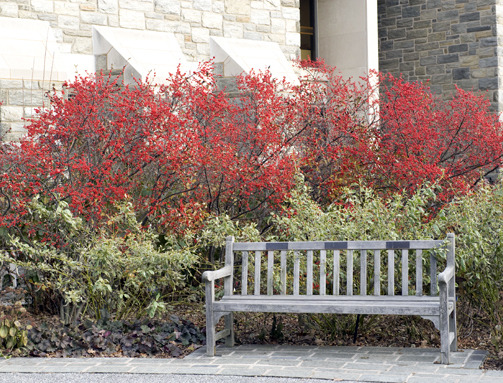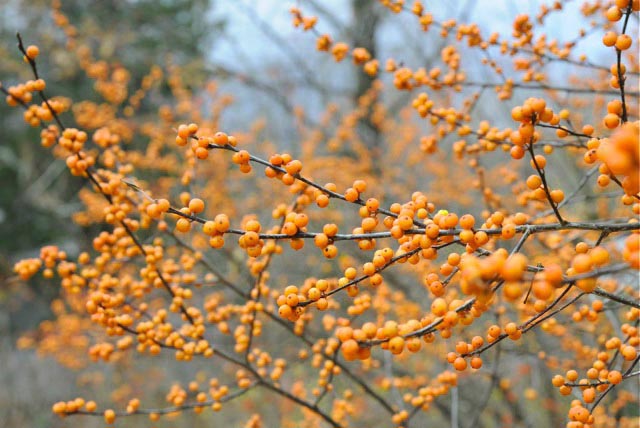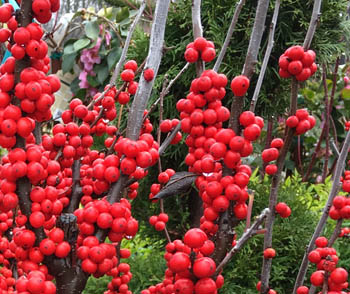Plant Some Winterberries Already!
By Jo Anna Natale, Fairfax Master Gardener

‘Sparkleberry’ – hybrid of common winterberry and Japanese winterberry holly
We all have a list of pending promises to ourselves that, for no good reason, we are slow to realize: Why haven’t I lost that 10 pounds yet? Or, why haven’t I repainted the kitchen yet? For me, one unanswered question that keeps pinging in my mind is, “Why haven’t I planted some winterberries yet?”
Why haven’t I? Winterberry, a deciduous holly, has much to recommend it. The common type (Ilex verticillata) is native to Virginia and a good chunk of North America, and the Virginia Cooperative Extension includes it on its list of problem-free shrubs. Though it has its preferences, winterberry holly isn’t particularly fussy about soil or exposure, isn’t plagued by many insects or diseases, and isn’t routinely ravaged by deer. But, without a doubt, the best reason to plant it is for its berries, which color up dull landscapes when we need the excitement most.

‘Winter gold’ cultivar produces orange-yellow berries
After the shrub sheds leaves in fall, its berries sing through winter, and, depending on the cultivar, cheer landscapes with happy tones of red, orange, or gold. While merely stunning to us winter-weary humans, the berries provide real nutrition for many birds when nature otherwise offers little. For these reasons alone, winterberry deserves a place in yards that can meet its modest conditions.
In my defense, I did try to plant one once, but I blew it. I wasn’t a master gardener then, with knowledge of such things, and I was in a hurry to landscape a bare backyard ravaged by new construction. No time to read directions, and in my impatience I failed to realize one crucial thing: Winterberries are hollies — albeit deciduous ones — and like all hollies, the female requires a nearby male in order to produce fruit. I neglected to install the male, and my lonely lady perished, fruitless, a few years later.

Ilex verticillata berries
To ensure success with winterberries, remember these points: They prefer moist, acidic soils and even swampy ones, but will do OK in drier areas with some supplemental watering. Winterberries will grow in part-sun conditions, but berry production will improve if the site is sunnier. Above all, learn from my mistake and plant a male pollinator for your female. Specific female cultivars require specific male cultivars, so ascertain the right match, and then plant it within 50 feet of the female. Usually, one male can pollinate up to six females, but again, check the specific requirements of the cultivar you select.
Winterberries can serve as specimen plants but, if you have room, group five or seven together to create a vibrant expanse of magnetic color. At holiday time, you will have an abundance of berried branches to jolly up your living space.
Some popular female cultivars of common winterberry include
- ‘Winter red’ — Loved for their heavy red-berry production, these grow 6 to 9 feet tall and wide. Plant the males ‘Jim Dandy’ or ‘Southern Gentleman’ to pollinate.
- ‘Red sprite’ — A more compact shrub that grows 3 to 5 feet tall and wide. ‘Jim Dandy’ or ‘Apollo’ will pollinate.
- ‘Afterglow’ — Produces orange-red berries. Grows up to 6 feet tall and wide. ‘Jim Dandy’ will pollinate.
- ‘Winter gold’ — Grows up to 8 feet tall and wide, produces orange-yellow fruit. Plant ‘Southern Gentleman’ to pollinate
Common winterberry crossed with Japanese winterberry (Ilex serrata) produces this popular hybrid:
- ‘Sparkleberry’ — Grows to 12 feet tall and produces dense, red berries that can last until spring. Plant in full sun for the most prolific berries. Plant ‘Apollo’ as its male pollinator.
It’s been 12 years since my failed attempt with a single winterberry, and for no clear reason, I still haven’t added new ones to my landscape. But as we head into another drab, twiggy season, I make a renewed promise to myself: By next winter, my yard will include these beneficial beauties. And so, I suggest, should yours.
References
• Common Winterberry, United States Department of Agriculture Natural Resources Conservation Service
• Ilex verticillata ‘Winter Gold’, Missouri Botanical Garden
• Ilex verticillata ‘Afterglow’, Missouri Botanical Garden
• Problem-free shrubs for Virginia Landscapes, VCE Publication 450-236
• Winterberry Holly, Piedmont Master Gardeners
… edited 2020